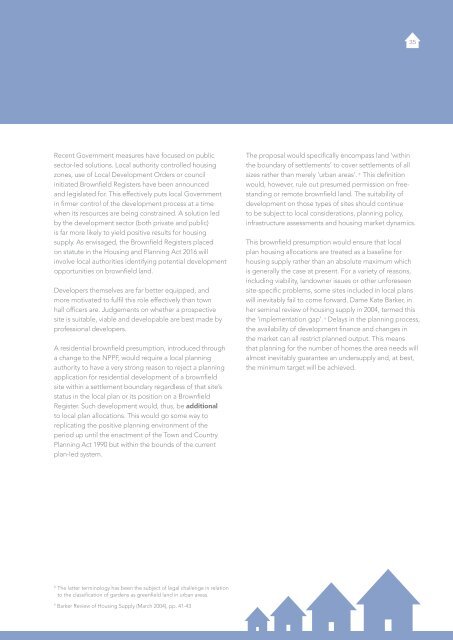Reversing the decline of small housebuilders
HBF_SME_Report_2017_Web
HBF_SME_Report_2017_Web
Create successful ePaper yourself
Turn your PDF publications into a flip-book with our unique Google optimized e-Paper software.
35<br />
Recent Government measures have focused on public<br />
sector-led solutions. Local authority controlled housing<br />
zones, use <strong>of</strong> Local Development Orders or council<br />
initiated Brownfield Registers have been announced<br />
and legislated for. This effectively puts local Government<br />
in firmer control <strong>of</strong> <strong>the</strong> development process at a time<br />
when its resources are being constrained. A solution led<br />
by <strong>the</strong> development sector (both private and public)<br />
is far more likely to yield positive results for housing<br />
supply. As envisaged, <strong>the</strong> Brownfield Registers placed<br />
on statute in <strong>the</strong> Housing and Planning Act 2016 will<br />
involve local authorities identifying potential development<br />
opportunities on brownfield land.<br />
Developers <strong>the</strong>mselves are far better equipped, and<br />
more motivated to fulfil this role effectively than town<br />
hall <strong>of</strong>ficers are. Judgements on whe<strong>the</strong>r a prospective<br />
site is suitable, viable and developable are best made by<br />
pr<strong>of</strong>essional developers.<br />
A residential brownfield presumption, introduced through<br />
a change to <strong>the</strong> NPPF, would require a local planning<br />
authority to have a very strong reason to reject a planning<br />
application for residential development <strong>of</strong> a brownfield<br />
site within a settlement boundary regardless <strong>of</strong> that site’s<br />
status in <strong>the</strong> local plan or its position on a Brownfield<br />
Register. Such development would, thus, be additional<br />
to local plan allocations. This would go some way to<br />
replicating <strong>the</strong> positive planning environment <strong>of</strong> <strong>the</strong><br />
period up until <strong>the</strong> enactment <strong>of</strong> <strong>the</strong> Town and Country<br />
Planning Act 1990 but within <strong>the</strong> bounds <strong>of</strong> <strong>the</strong> current<br />
plan-led system.<br />
The proposal would specifically encompass land ‘within<br />
<strong>the</strong> boundary <strong>of</strong> settlements’ to cover settlements <strong>of</strong> all<br />
sizes ra<strong>the</strong>r than merely ‘urban areas’. 8 This definition<br />
would, however, rule out presumed permission on freestanding<br />
or remote brownfield land. The suitability <strong>of</strong><br />
development on those types <strong>of</strong> sites should continue<br />
to be subject to local considerations, planning policy,<br />
infrastructure assessments and housing market dynamics.<br />
This brownfield presumption would ensure that local<br />
plan housing allocations are treated as a baseline for<br />
housing supply ra<strong>the</strong>r than an absolute maximum which<br />
is generally <strong>the</strong> case at present. For a variety <strong>of</strong> reasons,<br />
including viability, landowner issues or o<strong>the</strong>r unforeseen<br />
site-specific problems, some sites included in local plans<br />
will inevitably fail to come forward. Dame Kate Barker, in<br />
her seminal review <strong>of</strong> housing supply in 2004, termed this<br />
<strong>the</strong> ‘implementation gap’. 9 Delays in <strong>the</strong> planning process,<br />
<strong>the</strong> availability <strong>of</strong> development finance and changes in<br />
<strong>the</strong> market can all restrict planned output. This means<br />
that planning for <strong>the</strong> number <strong>of</strong> homes <strong>the</strong> area needs will<br />
almost inevitably guarantee an undersupply and, at best,<br />
<strong>the</strong> minimum target will be achieved.<br />
8 <br />
The latter terminology has been <strong>the</strong> subject <strong>of</strong> legal challenge in relation<br />
to <strong>the</strong> classification <strong>of</strong> gardens as greenfield land in urban areas.<br />
9<br />
Barker Review <strong>of</strong> Housing Supply (March 2004), pp. 41-43


